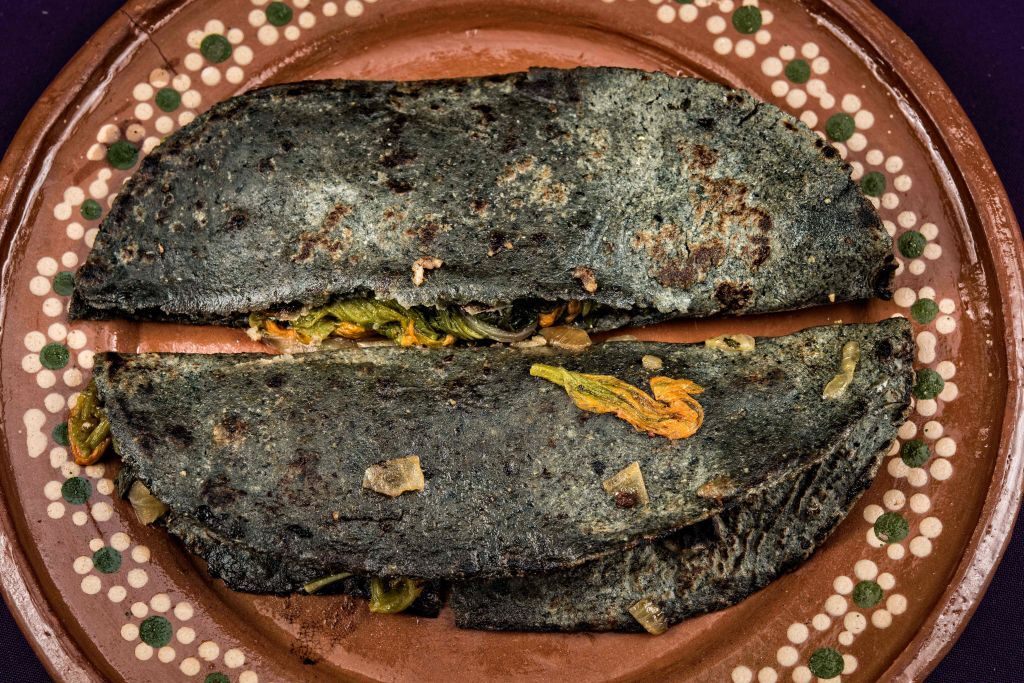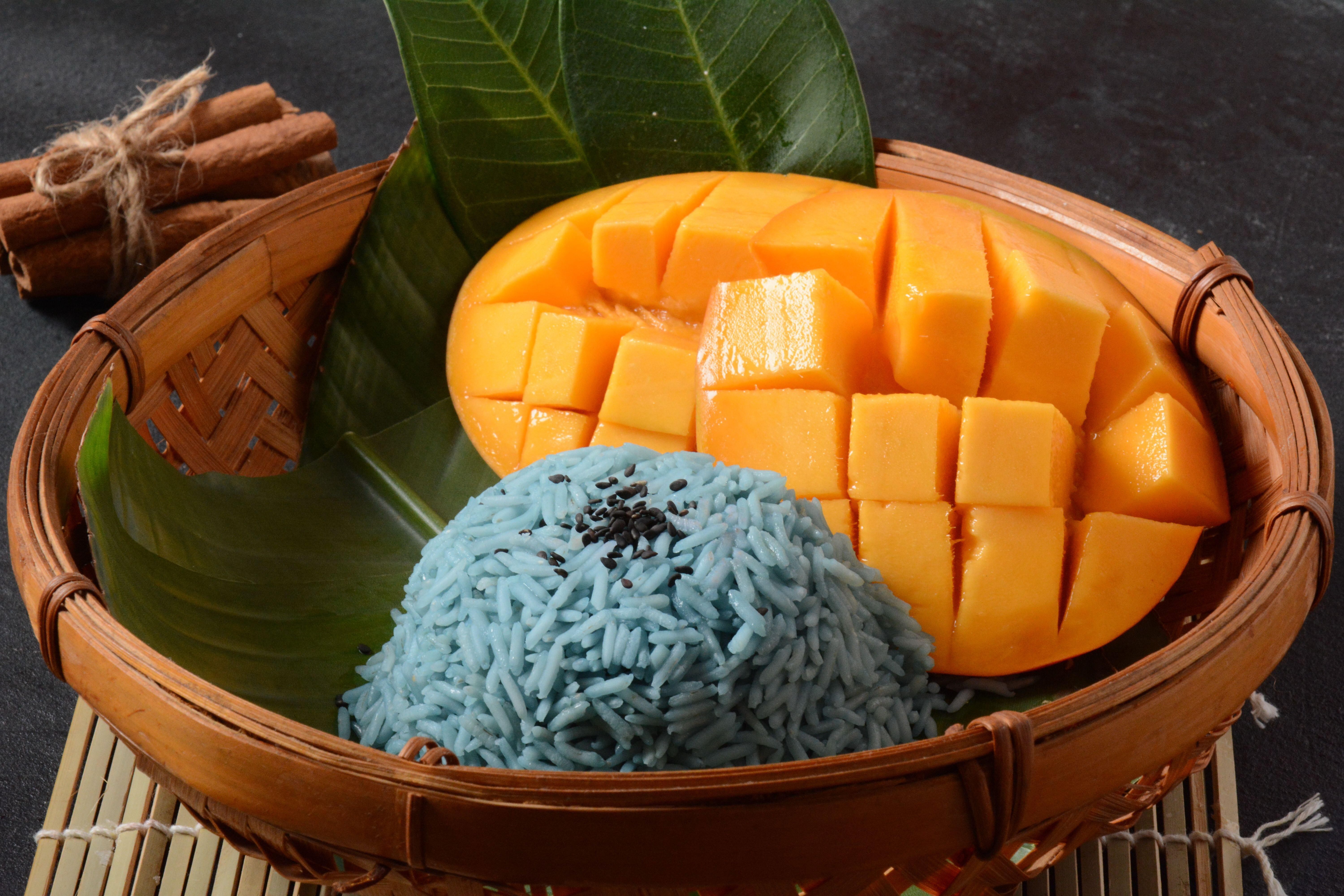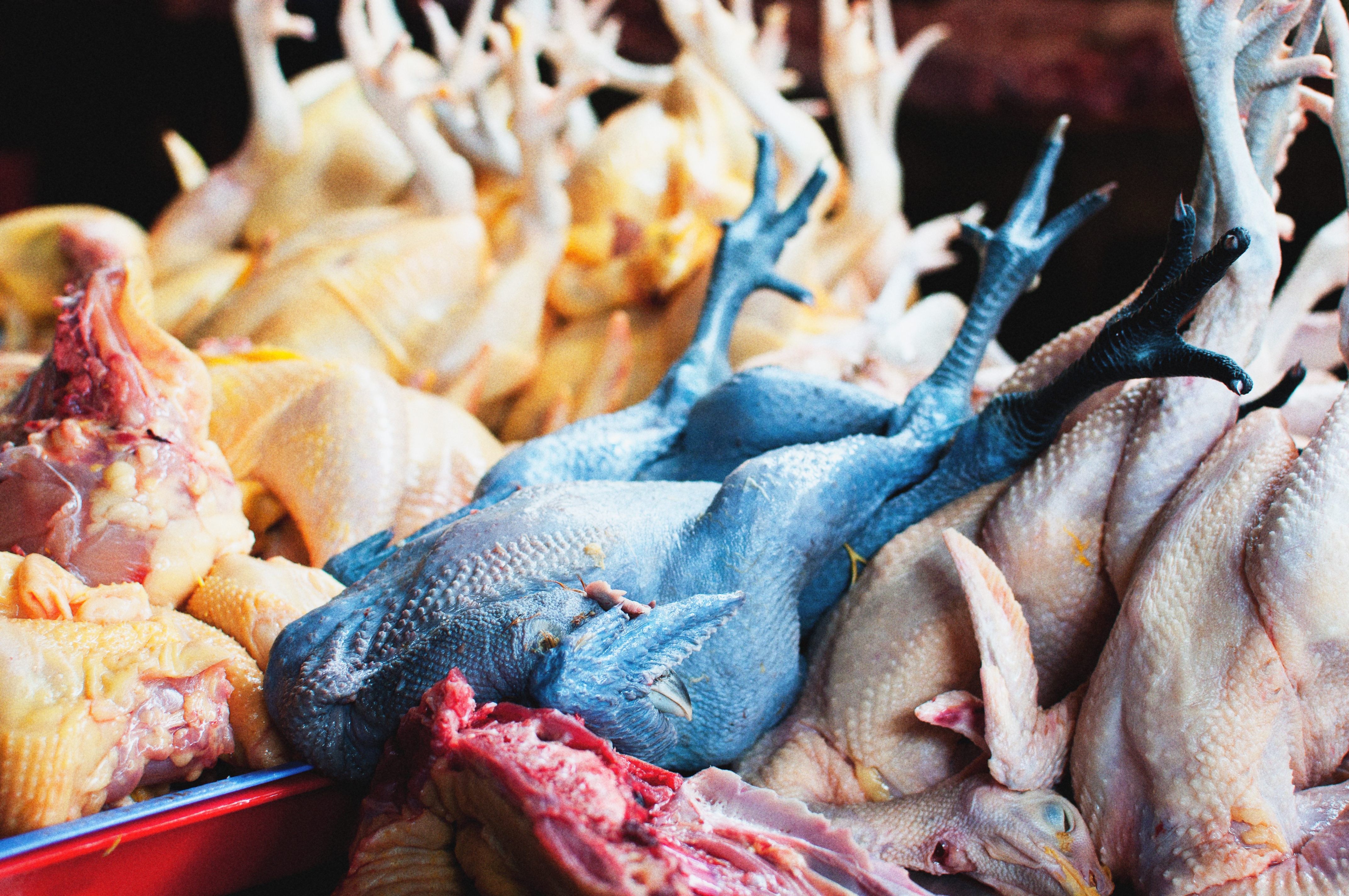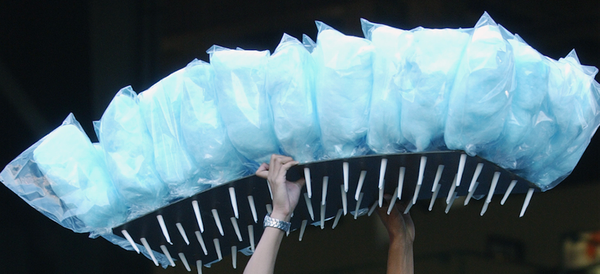“When people in different parts of the world are asked to rank their favorite colors, without any context,” says Charles Spence, an experimental psychologist at Oxford University, “it always comes out that blues and greens are preferred.” But what happens when people are asked about their favorite food colors? According to Spence, blue and green “drop right down” the list.
At first, this might seem counterintuitive. Spence points out that our love for blue and green may be due to their association with water and vegetation, the necessities of life. But while green is the color of fresh produce, “there are so few blue foods that we consume,” says Spence. Blue is rare in nature, found in only about 10 percent of all flowering plants. Even when the color does appear in living things, it’s usually an optical illusion, caused by the refraction of different-colored pigments layered together on a molecular level. The only organisms carrying genuine blue pigment are a few species of butterflies and fungi.
But blue’s rarity makes it special. When it comes to the colors of food, says Spence, “there will be more cultural, political, historical, and individual variation in the meaning of blue, since it is more or less an arbitrarily introduced color.” We recognize red as the natural hue of ripe strawberries, raw steak, and crisp radishes, among other foods. But with blue, says Spence, “there’s no natural associations.”
This means that blue is a culinary tabula rasa, a blank slate onto which chefs—or advertisers—can project any meaning they desire. Spence points out that even the same shade of blue can symbolize different flavors. A blue raspberry snow cone, minty blue mouthwash, and blue Curaçao—which is actually orange-flavored—all share the same bright color. But in each case, that color indicates a different flavor, and you wouldn’t necessarily expect a blue food from a different category, like a cookie, to taste like any of them.

Because people don’t have one solid expectation of what blue should taste like, food marketers “can teach people the new meaning, and hence it becomes acceptable,” says Spence. Different consumer markets will also learn different color associations. In 2010, Spence led a study in which British and Taiwanese participants were asked to guess the flavor of drinks based on their color, including one that was a translucent blue. While most British people guessed that this beverage was blue raspberry-flavored, in Taiwan, where blue raspberry is unfamiliar, people guessed it was mint-flavored because of its resemblance to mouthwash.
One of the only staple foods with a naturally blue appearance is blue corn, cultivated since ancient times by Indigenous people in Mexico and the American Southwest. But the natural blue of Navajo corn, like the mold in blue cheese, is more subdued than the brilliant pool water shade of artificially dyed foods like Gatorade or Takis. However, the relative rarity of bright blue natural ingredients has never stopped people from trying to achieve that color in food, if only as a novelty. “There’s a sort of playful, frivolous element” to blue when it appears in dishes, says Spence. “Its presence implies it must be there just for its own sake; as entertainment, not part of the flavor.”
Blue food’s entertainment value has long been recognized. In the third century, the Roman emperor Elagabalus, known for his elaborate culinary entertainments, was said to serve fish “cooked in a bluish sauce that preserved their natural color, as though they were still in the sea-water.” Medieval European banquets delighted guests with mawmenny, a dish of Arab origin consisting of meat in a creamy sauce that could be dyed red, yellow, blue, or other colors.
Such hues might have been achieved with plant-based dyes like red cabbage—still called “blue cabbage” in some German dialects—or woad, allegedly used for blue warpaint by the ancient Britons. Orchil, another blue dye derived from lichen, is referenced in the 14th-century Forme of Cury, the earliest known English cookbook. Blue butterfly pea flower has a long history of culinary use in its native Asia, as does another plant which the Greeks and Romans dubbed indigo for its Indian origin.

Many of these colorants were primarily employed for fabric, and not all are considered safe for human consumption today, which is why you’re unlikely to find indigo at your local supermarket. Another downside of natural blue dyes is that their color is often unstable, fading quickly or shifting to purple or pink with changes in pH. In comparison, the relative reliability of synthetic blue dyes has long made them desirable.
“Synthetic or chemical dyes started being introduced into food almost as soon as they were invented,” says food historian Carolyn Cobbold, author of A Rainbow Palate: How Chemical Dyes Changed the West’s Relationship with Food. In 1856, British chemist William Perkin accidentally created a purple dye while attempting to synthesize quinine from coal byproducts, leading to a boom of other chemical dyes. “At the same time this was happening,” says Cobbold, the food system was industrializing, and “when you start processing food more, it inevitably loses its color.” New chemical dyes were a less obviously harmful alternative to toxic metallic dyes like arsenic, and by the late 19th century, a dizzying number of chemical dyes were being used to replace, or standardize, the natural hue of processed ingredients.
But since blue is so rare in nature, food was rarely colored blue in the 19th century, says Cobbold, because food dye was usually used “to make food look healthier and unprocessed.” She also notes that early chemists “couldn’t find a [blue] dye that wouldn’t stain one’s mouth.” However, 19th-century manufacturers did use a small amount of blue dye to enhance the color of white sugar. “If you put blue in it, it just makes it a starker white,” says Cobbold. The same principle of color theory can be seen in liquid or powdered laundry “bluing,” used in small quantities to brighten white fabric.
“Even in the 19th century, there was concern over food colorings,” says Cobbold, though “the fact that dyes could enable the food to be adulterated” was initially of greater concern than the health risks of the dyes themselves. Over time, consumers embraced—and even came to expect—the enhanced appearance of dyed food products, but it was difficult to determine the effects of dyes on the body. So beginning in the 20th century, food dyes started to be limited to those that had been specifically tested and found to be safe. In the United States, there were 15 approved food dyes by the 1930s, including one known as “Brilliant Blue.”

Another of these, a deep red called “Red Number 2,” was controversial even before it was found to be carcinogenic and ultimately banned in 1974. One company hesitant to use Red Number 2 hit on a creative workaround. “In 1958, there was a company based in Cincinnati called Gold Medal,” says Cobbold. “They developed a new raspberry flavor, but they were concerned about using the red dye, so they decided to use blue.” And with that, blue raspberry was born. “I haven’t seen any archive material as to why they decided to use blue,” Cobbold adds, “but they did, and it was hugely successful.”
Perhaps blue raspberry’s success was in part due to the lack of blue foods then on the market; consumers had not yet learned to associate blue with any other flavor. Making raspberry blue also helped cut down on confusion with other popular flavors associated with red, like strawberry and cherry. Another significant factor was that the bright blue color—and its tongue-staining tendency—was appealing to children, the primary market for blue raspberry products.
Blue “works best not in staple foods and nutritional basics,” says Spence, “but in the ‘fun food’ category.” Even as blue candies and other “fun food” grew in popularity, blue staple foods remained exotic. Some 20th century provocateurs would serve blue food to deliberately disorient and test the stomachs of their dinner guests. The avant-garde banquets of the Italian Futurists in the 1930s featured blue wine, while in the 1960s, Alfred Hitchcock hosted cheeky dinner parties with all-blue menus, from martinis to prime rib.
Those ribs might have been especially hard for Hitchcock’s guests to accept. Research has found blue meat so consistently, and strongly, off-putting to consumers that Spence has suggested marketing it to decrease meat consumption via reverse psychology. As early as 1878, when the use of food dyes was at an all-time high, the British humor magazine Funny Folks mocked the idea of blue meat when describing a dye-obsessed chemist: “The eye, he thinks, is weary of the monotonous tints of fat and lean; and why, he would seem to be anxious to know, should not a mutton chop of azure with magenta fat, let us say, be a possibility?”

The more manufactured a food is, the more we can accept its being blue. We know implicitly that M&Ms and ice cream are processed, but with meat and fish, our expectations are different. Blue cotton candy has an air of cutesy novelty because it doesn’t look any more artificial than undyed cotton candy. Blue beef feels off-putting because it breaks the illusion of eating something in its natural state. Diners are also unlikely to enjoy a food being made blue if its natural color is part of its appeal, or used as an indicator of quality, flavor, or freshness. “The color of red wine might tell you something about the grapes that went into it,” says Spence. “That’s going to be a meaningful color.” In contrast, he says, “blue is nearly always arbitrary.”
Aside from its entertainment factor, in our modern marketplace, blue may be deliberately added to food products to help them stand out against competitors. This can apply to the color of the packaging or the color of the food itself. Gin company Bombay Sapphire has made its blue glass bottle a key part of its branding, but another company, London No. 1, went a step further in 2012 when they launched a blue gin in a clear bottle.
By the 1970s and 80s, concern was mounting about the health effects of chemical food colorings, and blue, as the most artificial color of them all, was viewed increasingly negatively. However, a shift happened in the late 20th century “with the arrival of natural blue food colorings, such as pea flower,” says Spence. Natural dyes that were safer than historical ones like indigo allowed companies to market blue food products with less fear of consumer backlash.

Butterfly pea flower is used in Southeast Asia to make traditional recipes like Malaysian nasi kerabu, blue coconut rice served with side dishes. Thanks to its uniquely vivid color and lack of strong flavor, the plant became globally available as a colorant around the early 21st century, though in the West it remains something of a boutique ingredient, more likely to be sold online by specialist vendors than in grocery stores. Like many blue plants, pea flower’s brilliant color is pH-reactive, making it unsuited as a food coloring in some contexts. But in others, like a striking cocktail or noodle dish, the “magic” color shift can be marketed as part of its appeal. “Some of our contemporary drink trends have been driven by Instagram-ability,” notes Spence. The colorful drama of a pea flower drink morphing from blue to pink with a squeeze of lemon juice is a visual treat.
Although there’s a wider range of options for creating blue food today, it continues to be a relative rarity outside fantasy realms like the Star Wars universe, where buffalo-like alien banthas produce blue milk (which can now be purchased at Disney’s Star Wars attractions). Though we might expect fun, novelty, and excitement from blue food, the color doesn’t necessarily make things look more delicious in the way that natural colors do. Intense red in tomatoes makes us anticipate good flavor, but blue can have the opposite effect. Spence points out that early consumer testers of London No. 1’s blue gin complained of “strange flavors that [they] thought this gin had,” because of its azure hue. “Even though the flavor doesn’t change,” he adds, “if the color changes, it changes the perceived flavor.”
So, what should blue taste like? In the end, different people may have wildly different expectations. But since the days of Elagabalus’s ocean on a platter, people have been making food blue to heighten the experience of eating. Nature’s rarest color may not enhance flavor and appetite, but it brings something to a recipe that no other color can. Blue adds mystery, surprise, delight, and even humor to our food; ingredients that can be just as important as any seasoning.
Gastro Obscura covers the world’s most wondrous food and drink.
Sign up for our email, delivered twice a week.

